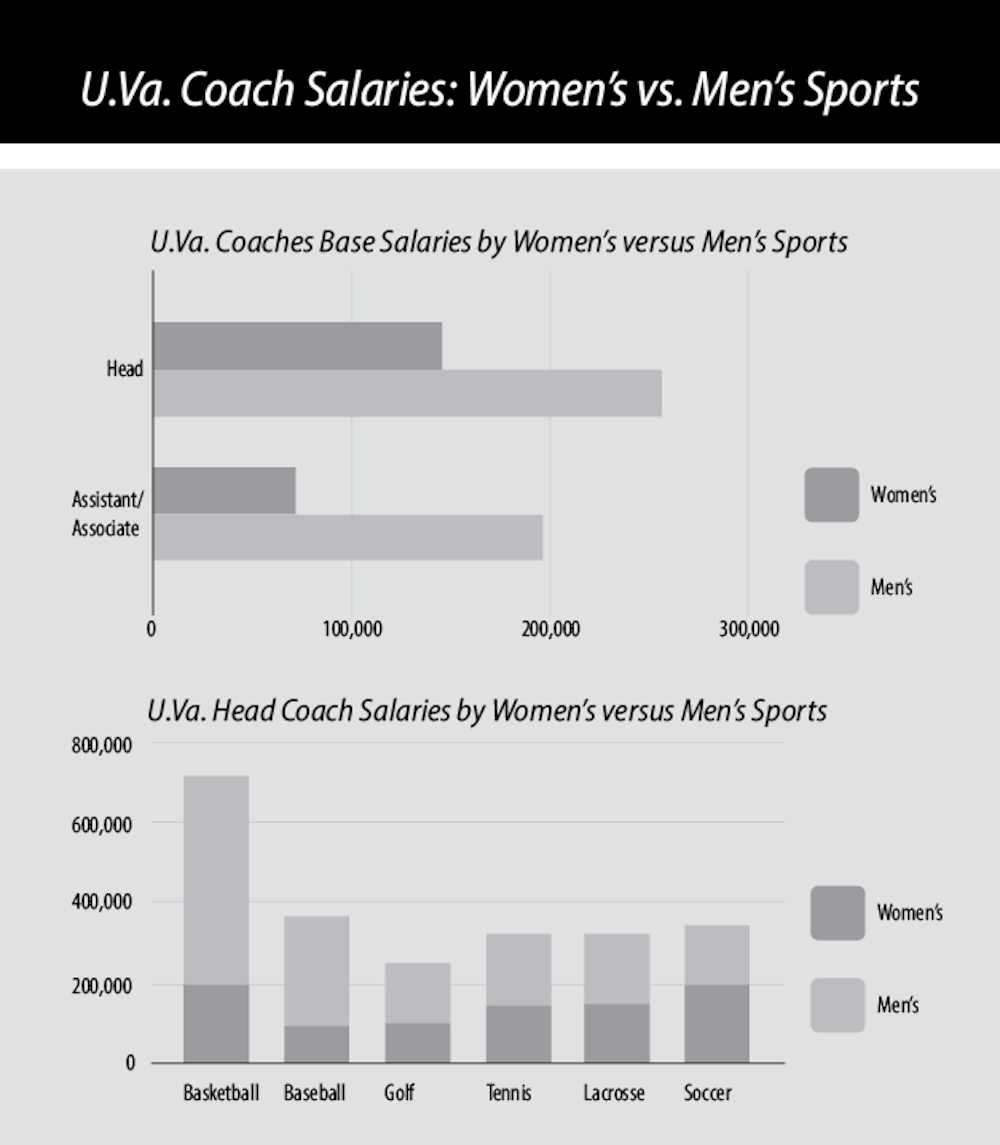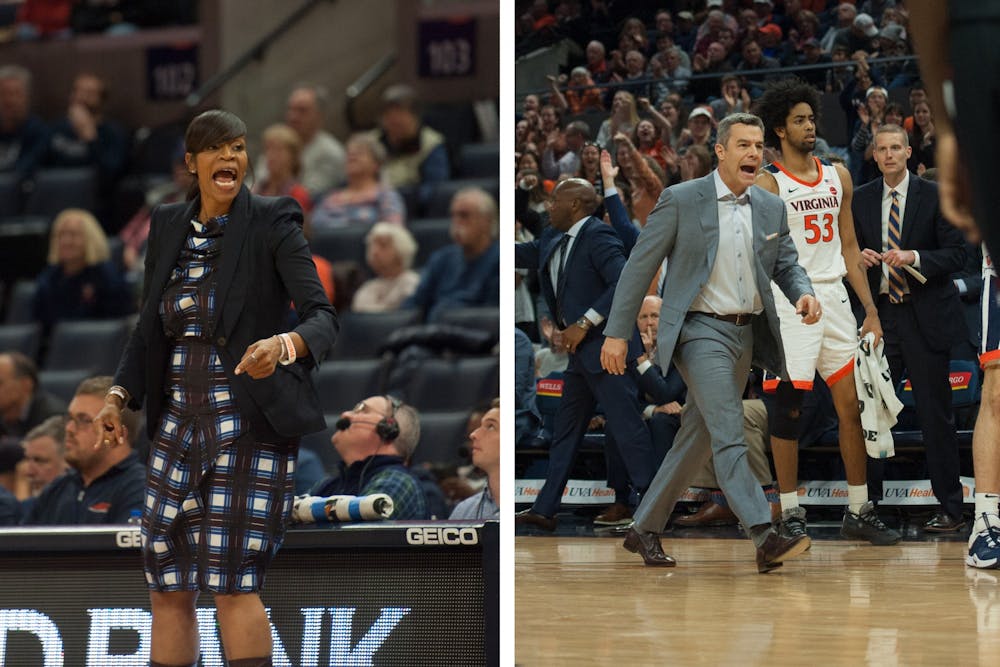Faculty and administration salaries for the 2018-2019 academic year show that, among the eight highest-paid coaches at the University, just two represent women’s sports.
Data obtained by The Cavalier Daily through a Freedom of Information Act request indicates that the average base salary of a coach of a women’s sport, $145,229, is 76 percent less than the average base salary of a coach of a men’s sport, $256,125. Additionally, the average base salary of a coach of both male and female athletes is $131,887 — this includes track and field, swimming and diving and squash.
This discrepancy in base salary is evident when taking a closer look at the six Virginia sports that have separate varsity-level male and female teams. In five of these six sports, the men’s coach outearns the women’s coach.

Men’s basketball Coach Tony Bennett earns $300,000 more than women’s basketball Coach Tina Thompson. Baseball Coach Brian O’Connor earns $177,058 more than softball Coach Joanna Hardin. Men’s golf Coach Bowen Sargent earns $54,500 more than women’s golf Coach Ria Scott. Men’s tennis Coach Andres Pedroso earns $36,050 more than women’s tennis Coach Sara O’Leary and men’s lacrosse Coach Lars Tiffany earns $25,649 more than women’s lacrosse Coach Julie Myers.
In fact, only women’s soccer Coach Steve Swanson — who has served as an assistant coach for the U.S. Women’s National Team — earns more than his counterpart for the men’s soccer team, Coach George Gelnovatch.
Notably, base salary is just one component of a Virginia coach’s total annual compensation. However, incentives and bonuses may actually exacerbate the salary gap further. For example, Thompson’s annual pay can reach $650,000 with incentives. Bennett, who declined a pay raise in September, can earn up to $5.2 million after accounting for his performance incentives, supplemental compensation and longevity bonus.
While coaches of men’s sports make more than those of women’s sports, the Virginia athletics department holds that “a number of non-discriminatory factors” are used to determine compensation packages.
“Seniority, merit, marketplace value, contractual requirements to perform other duties and production are all contributing factors,” said Jim Daves, assistant athletics director for media relations, in an email to The Cavalier Daily.
The value of coaching contracts is also highly situational. To remain competitive with other NCAA programs, the athletics department may occasionally offer higher pay to a coach as an incentive to stay at or come to Virginia. With the fourth-highest spend on coaching staff in the ACC, an aggressive job market is a driver in certain Virginia coaches’ salaries.
“There have been times where coaches have been recruited for employment by another university or organization,” Daves said. “In those instances, changes in compensation or salary have contributed to an increase in an overall compensation package in order to retain that individual.”
Moreover, the salary of a coach is tied to the financial value of their particular sport. For instance, in 2017-2018, men’s basketball generated $13,503,022 in revenue for Virginia athletics compared to $1,326,752 generated by women’s basketball. This difference in revenue may help explain the salary gap between Bennett and Thompson.
Virginia athletics’ salary gap extends beyond head coaches to the entire coaching staff. The average base salary of assistant and associate coaches of men’s sports is $196,570 — 173 percent more than the women’s sports average of $71,922. The highest-compensated assistant coaching staff members belong to football and men’s basketball with average base salaries of $283,333 and $280,819, respectively. In contrast, the assistant coaches of six women’s sports — volleyball, field hockey, soccer, rowing, golf and softball — have average base salaries of less than $60,000. Just one men’s sport — golf — falls below that line.
While the current salary gap is still large, compensation for coaches of women’s sports has been progressively increasing over the course of the last decade. The average base salary of a Virginia head coach of a women’s-only team has increased 15 percent, or by $18,973, since 2011-2012. Excluding women’s basketball — an extreme outlier in this data and the only sport whose head coach’s base salary dropped — the average base salary actually grew 33 percent in the last seven years. Women’s soccer, volleyball and rowing had the biggest increases in head coach base salary — all three saw at least 39 percent growth.
However, less has improved in terms of gender diversity as male coaches still easily outnumber female coaches. The University has 14 male head coaches to only six female coaches. In addition to every men’s team, three women’s teams and all sports that have both men and women under one staff are coached by a male.
Abigail Palko, director of the Maxine Platzer Lynn Women’s Center, touched upon the challenge of increasing the involvement of women in Virginia athletics and the progress made so far.
“Given U.Va.'s history as an all-male university for its first 100 years, the slow admission of women in the professional and graduate schools from 1920-1970, and then the full integration of the college in 1970, the history of women's participation in athletics — as players and coaches — is complicated,” Palko said in an email to The Cavalier Daily. “A number of women have had a significant impact in recent years, including [Athletics Director] Carla Williams and [former Assistant Athletics Director] Jane Miller.”







